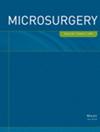One versus two vein anastomoses in breast reconstruction with a profunda artery perforator flap—does it make a difference
Abstract
Background
The profunda artery perforator (PAP) flap has gained popularity as a reliable alternative in breast reconstruction. Extensive research has focused on its vascular supply, dissection techniques, and broader applications beyond breast reconstruction. This study aims to investigate the correlation between the number of veins anastomosed for the PAP flap and postoperative complications.
Methods
A retrospective study was conducted to evaluate the outcomes of breast reconstructions with PAP flaps at our institution between 2018 and 2022. A total of 103 PAP flaps in 88 patients were included. Statistical analysis was performed to compare outcomes between flaps with one vein anastomosis and those with two vein anastomoses. Patient characteristics, intra and postoperative parameters were analysed.
Results
One vein anastomosis was used in 36 flaps (35.0%), whereas two vein anastomoses were used in 67 flaps (65.0%). No significant differences were found in patient characteristics between the one vein and two vein groups. The comparison of ischemia times between flaps with one versus two veins revealed no statistically significant difference, with mean ischemia times of 56.2 ± 36.8 min and 58.7 ± 33.0 min, respectively. Regarding outcomes, there were no statistically significant differences in secondary lipofilling, revision of vein anastomosis, or total flap loss between the two groups. Fat necrosis was observed in 5 (13.9%) one vein flaps and 5 (7.5%) two vein flaps, indicating no statistically significant difference between the two groups (p = .313). In the one vein group, the most frequently employed coupler ring had a diameter of 2.5 mm. In the two vein group, the most prevalent combination consisted of a 2.0 mm diameter with a 2.5 mm diameter.
Conclusion
Based on our study results, both one vein anastomosis and two vein anastomoses are viable options for breast reconstruction with PAP flap. The utilization of either one or two veins did not significantly affect ischemia time or flap loss. Fat necrosis exhibited a higher incidence in the single-vein group; however, this difference was also not statistically significant. These findings underscore the effectiveness of both approaches, providing surgeons with flexibility in tailoring their surgical techniques based on patient-specific considerations and anatomical factors.

 求助内容:
求助内容: 应助结果提醒方式:
应助结果提醒方式:


